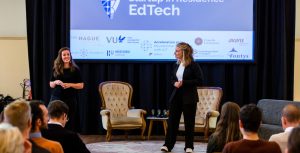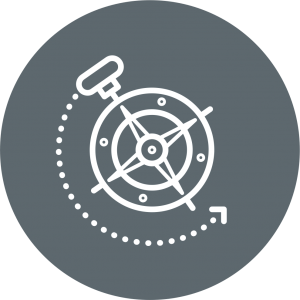
This was the first edition of Startup in Residence EdTech
From more and high-quality responses to course evaluations to monitoring students’ academic writing skills. Since October 2022, startups and higher


The Union of Utrecht (Unie van Utrecht). The working title of the National Approach to Digital and Open Educational Resources. If your knowledge of Dutch history is a little rusty, it suffices to know that on 23 January 1579 a number of Dutch provinces signed an agreement to join forces and chase the Spaniards out of the country. The first Union of Utrecht was a historical document. It’ll be no less so for the second one.
We can do more with digital educational resources than we currently do. Lecturers create their own educational resources and educational institutions buy licenses for using digital educational resources from publishers. There is hardly any control at the national level. That’s a shame, because the practical thing about digital resources is that you can basically share them, adapt them, and reuse them, regardless of whether they have been purchased or who has created them. The Accelerating together zone, which comprises of 17 university and university of applied sciences board members, therefore aims to create a cross-institutional ecosystem for digital educational resources in higher education and research.
Initiatives to promote the sharing and reuse of learning resources have been in place for years. Why did the Koersteam see an opportunity for a national approach now? “Because the time is right,” says Theo Bastiaens, rector magnificus of the Open University and leader of the Accelerating together zone with Elisabeth Minnemann (The Hague University of Applied Sciences). The thousand flowers blooming principle must gradually make way for a more promising, sustainable embedding. That’s why we commissioned Huib de Jong to look into whether such a thing is feasible. This isn’t just down to the instructors willing to start working with OERs, but the entire system: the institutions, the Ministry, and quality control. It’s a complex story. We are pleased Huib has agreed to take on this task. (chuckles)
The first steps have been taken with a research into the current state of affairs by ResearchNed and a vision document by the zone Towards digital (open) educational resources. It’s now up to influence peddler Huib de Jong, former chairman of the UvA–HvA board, to investigate whether and how an ecosystem for educational resources is possible. The zone gave him two ‘moonshots’: a national initiative for developing and using/reusing OERs, and a national system of agreements, and joint purchasing of copyright-protected educational resources. You name it. Not coincidentally, De Jong is known as someone who likes to connect and seek dialogue between parties.
At the moment, all knowledge institutions are struggling with the same problems,” he says. Universities and universities of applied sciences strive for high-quality education. They do so on the basis of traditional values. They want to offer quality content, organise accessibility to education, and provide a safe learning environment for students. With the arrival of technology, these values are no longer self-evident. That’s why we need to discuss possible solutions. Because people widely recognise the problem, I have the idea that there is support for organising mutual cooperation.
Bastiaens: “Why not make a joint effort to guarantee the quality of educational resources in higher education? We can work more efficiently and effectively by sharing expertise, knowledge, and materials. The idea existed before the pandemic, but now technology has advanced, more and more educational resources are available, and the costs of digital educational resources are rising. By which, incidentally, I don’t mean to suggest this is a cost-saving exercise. The innovation of education is essential in this story.”
In the months leading up to the summer, the quartermaster used the opportunity to hold many discussions with people within higher education who are involved with educational resources. De Jong: “I wanted to get a feel for the vision paper and the plans of the Digital Open Educational Resources zone. The conclusion was we shouldn’t reinvent the wheel but rather capitalise on what has already been developed. The zone is explicitly asking for administrative support and action to take its ambitions further. The members have already passed the stage of pilots. But for the next phase, they say, we need a vision from the administrators, including a clear position on financial and other scope and appreciation for the development of learning materials.
The quartermaster also went in search of cross-links within the Acceleration Plan. The Evidence-informed educational innovation with IT zone knows all about capitalising on available knowledge. The Facilitating professional development for lecturers zone knows a lot about professional development for lecturers in this context. How can we organise connections? Are there any clever ideas for optimising this, perhaps by improving the connection with administrative discussions? The answer to these questions is that I think it can be done. (laughs)
The market for copyright-protected educational resources is at a turning point, warns ResearchNed’s report: not only is there a shift from analogue to digital educational resources, there’s also a shift in the type and number of providers with changing business models. Data analysis is one such new form of service. The higher education institutions currently have hardly any control over this part of the chain.
Talks with publishers are planned for the autumn. What do you expect from them?
De Jong: “As I see it, we are looking for a new balance. Publishers provide an important stimulus for educational innovation through the design of educational resources. But for the knowledge institutions, there is the question that the rector magnificus of the UvA, Karen Maex, emphatically formulated in her Dies Natalis speech: what are the values that we, as educational institutions, want to safeguard? We need to have good conversations about the accessibility of education, the cost issue, but also the safety of students and teachers when using educational resources. What happens to data on learning performance and individuals when they access platforms developed by publishers? With all parties involved, let’s mutually acknowledge the differences in interests, but also find a mode to further strengthen education.”
What has surprised you most so far?
De Jong: “That so much is already on the shelf. That calls for attention to communication. SURF has taken a great step forward with the development of edusources, but here too we need to improve visibility. We want to achieve this without disrupting ongoing programmes at institutions and without creating the impression lecturers have to get back to work. It’s business as usual.”
Bastiaens: “There’s an outdated image of the lecturer as a teacher who opens his textbook and rattles off their lesson. Today’s lecturers are education-makers who create learning situations with the aid of sources from all kinds of channels. Lecturers think it’s perfectly normal to be the director of the learning process. The next step is for those resources to be shared. That is indeed no more than business as usual.
Huib: “This is in line with the Recognition and Rewards programme of the Association of Universities in The Netherlands. Making the design part of education visible is important. Within the universities of applied sciences this is also on the agenda, often in terms of function differentiation in education. I always find it a challenge to connect existing things in order to accelerate transformation processes.”
What is already in the ‘charcoal sketch’ you are working on?
De Jong: “We want to discuss the positioning of educational resources, the recognition of their great importance, and how the institutions want to give shape to them within their own ranks: recognising and valuing them. A second topic is the openness of learning resources. How do we use edusources as a showcase for shared use? How can innovation be organised jointly? And to what extent can departments facilitate this innovation effectively? I’d like to forget the idea of efficiency gains in educational innovation. Education’s in fact becoming more intensive. That’s why more direction from the educational institutions is so important. This requires investment for the longer term, but also for the transformation phase for the universities of applied sciences.”
The vision paper for the Digital (open) educational resources zone includes a proposal that the costs of all learning resources should be borne by the institutions instead of the students. What do you think about that?
De Jong: “I still don’t really see to what extent it’s feasible. Digital educational resources are more expensive than the educational resources of the past. The cost issue will have to be resolved. If we pass these costs on to students, we will be limiting the accessibility of education. But it is not possible to simply pass it on to the institutions, because they cannot afford it. Perhaps it would be good to have a good discussion with the department to see how that can be arranged. Now I’m just going to smile politely.” (laughs kindly)
Theo Bastiaens says as co-team leader of the Accelerating together zone, he is curious about the influence peddler’s final report. It will be a growth model, that’s for sure. It’s not a question of turning a few knobs. We need time.
De Jong: “Time and continuity. Don’t throw away what’s been built up. I’d be a great advocate of an Acceleration Plan 2.0.”
Bastiaens: “May I add priority to that? This has also been different in the past.” De Jong: “That’s why the choice of learning materials from the Accelerating together zone is an important one. This is the subject that’s the least visible in policy discussions, while it’s the core of what education is about.”
Text: Marjolein van Trigt
Image: Akram Huseyn on Unsplash
Share this page

From more and high-quality responses to course evaluations to monitoring students’ academic writing skills. Since October 2022, startups and higher

This article was written by: Mira Buist-Zhuk, Hans Beldhuis, Susanne Täuber (University of Groningen) & Robert Schuwer (captain of the Educational

The Acceleration Plan for Educational Innovation with ICT officially comes to an end at the end of this month after

Author: Berent Daan, programme director Digitalisation Catalyst When I came across the vacancy for the Programme Director of the Digitalisation